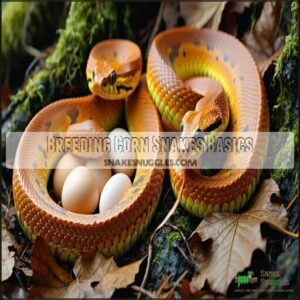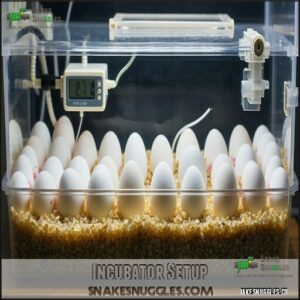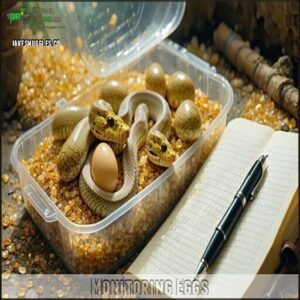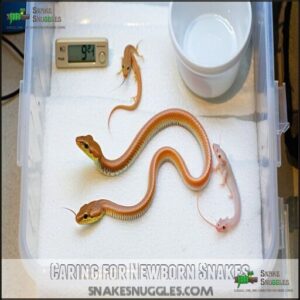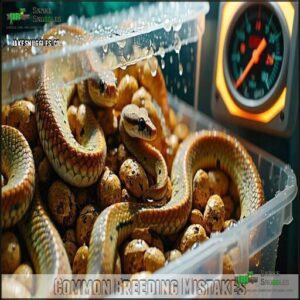This site is supported by our readers. We may earn a commission, at no cost to you, if you purchase through links.

To get started, you’ll need to understand the basics of their breeding cycle, including brumation, mating, and incubation.
You’ll need to choose healthy snakes, set up a suitable environment, and monitor their behavior.
When you’re ready to breed, you’ll introduce the male and female, and then incubate the eggs.
With proper care, you can increase your chances of successful hatchlings.
Now, let’s explore the intricacies of breeding corn snakes and uncover the secrets to a successful breeding season, starting with the essential first steps.
Table Of Contents
- Key Takeaways
- Breeding Corn Snakes Basics
- How to Breed Corn Snakes
- Preparing for Breeding
- Corn Snake Mating Process
- Incubation and Egg Care
- Caring for Newborn Snakes
- Breeding Corn Snakes Without Brumation
- Common Breeding Mistakes
- Genetic Considerations
- Breeding Corn Snakes Successfully
- Frequently Asked Questions (FAQs)
- What is the Best Way to Sex a Corn Snake?
- How Often Should I Feed Adult Corn Snakes?
- Are There Any Special Incubation Requirements for Corn Snake Eggs?
- How Do I Know When Corn Snakes Are Ready to Mate?
- Are corn snakes hard to breed?
- How to make corn snakes breed?
- How long does it take to breed corn snakes?
- How many times can you breed a corn snake?
- What age do corn snakes reach maturity?
- Can corn snakes breed in small spaces?
- Conclusion
Key Takeaways
- You’ll need to understand the basics of corn snake breeding, including brumation, mating, and incubation, to increase your chances of successful hatchlings.
- To breed corn snakes, you’ll have to choose healthy snakes, set up a suitable environment, and monitor their behavior, ensuring they’re at least 2-3 years old and in prime health.
- You’ll have to maintain a proper incubation setup, with temperatures between 78-80°F and humidity levels at 75-80%, and monitor the eggs regularly for signs of mold or denting.
- After the eggs hatch, you’ll need to provide the newborn snakes with proper feeding, housing, and environmental conditions, including a thermogradient with a warm side at 84-86°F and a cool side at 68-75°F, to ensure their survival and healthy development.
Breeding Corn Snakes Basics
You’ll need to verify your corn snakes are mature and healthy before breeding, with males at least 2 years old and females at least 3 years old, weighing over 300 grams.
Mature corn snakes, 2-3 years old, are ideal for breeding, ensuring healthy offspring.
The breeding process follows a natural cycle that includes brumation from December to February, followed by warming and mating in spring, with eggs typically appearing 30-45 days after successful mating, which is a critical part of the breeding process.
Equipment Needed
To successfully breed corn snakes, you’ll need proper equipment for every stage of the process. Your breeding success depends largely on having the right tools ready before you begin.
Here’s what you’ll need:
- Nesting boxes with moisture-retaining substrate like coconut fiber
- An incubator with reliable temperature and humidity control
- Incubating medium such as vermiculite or sphagnum moss
- Separate hatchling housing with appropriate heat gradients
Consider incubator temperature control for successful hatching.
Breeding Cycle Timeline
Now that you’ve gathered your equipment, let’s walk through the corn snake breeding timeline. Understanding the cycle helps time each step correctly.
The female will shed 4-6 weeks post-mating, signaling egg-laying is near. Expect hatching about 8 weeks after eggs are laid.
| Phase | Timeframe | Key Events |
|---|---|---|
| Brumation Length | Dec-Feb | Cooling snakes (60-65°F) |
| Mating Season | Mar-Apr | Male shed, female ovulation |
| Egg Development | May-Jun | Eggs laid 30-45 days after mating |
Choosing Healthy Snakes
Healthy snakes form the foundation of successful corn snake breeding.
You’ll need to perform a thorough visual inspection of potential breeders, checking for clear eyes, smooth scales, and proper weight.
Implement quarantine protocols for new additions before introducing them to your collection.
Consider age—males should be at least 2 years old and females 3 years old.
Temperament assessment and genetic screening help prevent passing problematic traits to offspring.
How to Breed Corn Snakes
Now that you understand the basics, let’s walk through the breeding process step-by-step. Breeding corn snakes requires patience and knowledge of morph genetics to achieve successful results.
Breeding corn snakes demands patience and a deep understanding of genetics for successful results
You’ll need to time the breeding season correctly, usually beginning in April after brumation. Color variations and breeding morphs depend on your careful selection of compatible parents.
When starting your corn snake breeding journey:
- Your heart will race when you see your first successful "lock" between breeding pairs
- You’ll feel immense pride watching your female develop eggs from your careful management
- The anticipation while waiting for corn snake eggs to develop can be nerve-wracking
- Nothing compares to the joy of seeing your first hatchling emerge
Ethical breeding practices should always guide your decisions. Be cautious about hybridization concerns when working with different morphs to avoid genetic issues in offspring.
Preparing for Breeding
You’ll need to prepare your corn snakes properly before breeding by ensuring they’re at least 2-3 years old and maintaining prime health through proper brumation.
The success of your breeding program depends on carefully managing temperature cycles, providing appropriate nutrition, and correctly identifying the sex of your snakes to create compatible pairs.
Brumation Process
Brumation is a winter cooling period that can boost breeding success, though it’s optional for corn snakes.
During this process, you’ll gradually reduce temperatures to mimic natural winter conditions.
| Brumation Phase | Temperature | Light Hours |
|---|---|---|
| Early (Week 1-2) | 65-70°F | 8 hours |
| Middle (Week 3-10) | 55-65°F | 6 hours |
| Late (Week 11-12) | 60-70°F | 8 hours |
Monitor weight throughout brumation to confirm snakes remain healthy during this reduced-activity period.
Warming and Feeding
After brumation ends, you’ll need to gradually warm your corn snakes back to normal temperatures. Start by raising the temperature 2-3°F each week until reaching 80-85°F.
Begin feeding corn snakes small prey items once weekly, then increase to 2-3 times weekly with properly sized mice. Proper post-brumation care includes maintaining consistent hydration and offering vitamin supplements to females preparing for egg production.
This feeding frequency builds the energy reserves needed for successful corn snake breeding. A vital aspect is ensuring the correct calcium-to-phosphorus ratio for strong eggshells.
Sexing and Pairing Snakes
With your snakes now well-fed and warmed up after brumation, it’s time to confirm their sex and create compatible pairs.
Properly sexing corn snakes is your first critical step in breeding. Try non-invasive visual sexing methods before considering the popping technique or probe method.
Count scales after the cloacal or take photos of shed skin for easier assessment.
Remember, corn snakes should only be paired during breeding season, with Snow morph females often making excellent breeding partners.
Corn Snake Mating Process
You’ll need to introduce your male and female corn snakes in a neutral enclosure during spring months when both snakes show breeding readiness.
The mating process occurs naturally when the female releases pheromones, prompting the male to align his cloaca with hers for sperm transfer, typically lasting about 20 minutes before they separate.
Introducing Male and Female
After your preparation work, it’s time to bring your corn snakes together. For successful mating, you’ll need to introduce the male and female carefully.
The environment plays a vital role in this process.
- Use a neutral enclosure neither snake has claimed as territory
- Choose twilight hours for introductions when corn snakes are naturally active
- Place both snakes gently in the enclosure at the same time
- Monitor initial interactions for signs of stress or aggression
- Allow 10-15 minutes of supervised interaction before separating if no courtship begins
Signs of Receptiveness
Recognizing when your corn snakes are ready to mate is vital for successful breeding.
Watch for these key signs of receptiveness to time introductions properly.
| Female Signs | Male Signs |
|---|---|
| Tail twitching | Increased activity |
| Pheromone release | Head bobbing |
| Open-mouth gestures | Persistent following |
| Receptive posture | Tongue flicking |
When a female stops flagging her tail and resists advances, she’s no longer receptive.
Most females will accept mating 3-4 times before losing interest, which is a critical period for breeding, and it is essential to recognize the signs of receptiveness and receptive posture to ensure successful mating.
Mating Techniques
Now that you’ve recognized the female’s receptive signals, it’s time to facilitate the mating process.
Place both snakes in a neutral enclosure at dawn or dusk.
Lightly mist the area to enhance pheromone detection.
When successful copulation occurs, the pair will "lock" for 10-20 minutes.
Don’t disturb them during this time.
Repeat introductions every 5 days until the female shows resistance to the male’s advances.
Incubation and Egg Care
You’ll need to maintain your corn snake eggs at 78-80°F with 75-80% humidity in a proper incubation setup for approximately eight weeks until hatching.
During this critical period, you must regularly check for signs of mold or denting, which indicates either problems or approaching hatch dates.
Incubator Setup
Now that your corn snakes have mated, you’ll need a proper incubator setup for successful egg development. Your incubator placement matters—keep it away from drafty windows or direct sunlight to prevent temperature fluctuations.
For reliable incubation of corn snake eggs, follow these steps:
- Choose a substrate like vermiculite or sphagnum moss that retains moisture without becoming waterlogged
- Mix your substrate with water at a 1:1 ratio by weight
- Place eggs carefully, marking their original position to avoid disturbing them later. A proper setup requires a reliable corn snake incubator, which is crucial for the successful development of the eggs and ensuring they are properly cared for throughout the incubation period.
Temperature and Humidity Control
The delicate dance of temperature and humidity control determines your success rate with corn snake eggs.
Maintain incubation temperatures between 78-80°F (26-27°C) with 70-75% humidity for ideal development.
| Parameter | Ideal Range | Monitoring Tool |
|---|---|---|
| Temperature | 78-80°F | Digital thermometer |
| Humidity | 70-75% | Hygrometer |
| Substrate Moisture | Damp but not wet | Visual check |
Regular monitoring prevents fatal temperature fluctuations that could harm developing embryos.
For other snake species, this is a key consideration: ideal humidity levels may vary, and understanding ideal development conditions is crucial for incubation temperatures and humidity control.
Monitoring Eggs
Despite the waiting game, monitoring corn snake eggs daily is vital for successful hatchings.
Check for signs of rot (yellowing or molding), maintain 75-80% humidity levels, and verify incubation medium isn’t overly wet.
As hatching approaches, normal egg denting indicates hatch readiness – don’t panic!
Record egg viability in a journal and avoid handling snake eggs unnecessarily, as a hands-off approach with consistent monitoring creates the ideal incubation environment.
Caring for Newborn Snakes
You’ll need to provide your newborn corn snakes with appropriate feeding, housing, and environmental conditions immediately after hatching for ideal health and development.
Once they’ve completed their first shed within 5-7 days of hatching, offer pinky mice twice weekly.
While maintaining proper heat gradients of 84-86°F on the warm side and 68-75°F on the cool side, with adequate ventilation and a small water dish, is crucial for their development.
Feeding and Watering
Now that your eggs have hatched, proper feeding and watering will determine your hatchlings’ survival.
Newborn corn snakes require specific care:
- Start with pinky mice (thawed and warmed) once the hatchling completes its first shed, typically 5-10 days after hatching
- Offer water in shallow dishes that prevent drowning but allow soaking
- Feed every 5-7 days, increasing prey size as your snake grows
Never force-feed reluctant hatchlings—this often indicates stress rather than illness, and it is crucial to monitor their behavior to ensure they are receiving the proper care for their survival.
Heat and Humidity Requirements
Newborn corn snakes require precise temperature management for ideal development.
Maintain a hatchling thermogradient with warm side at 84-86°F and cool side at 68-75°F.
Monitor humidity levels at 70-75% during their first weeks, gradually reducing to 60-65% as they grow.
Use reliable monitoring tools to track these conditions daily.
Seasonal adjustments may be necessary, especially during winter months when ambient humidity drops substantially, requiring careful management of the thermogradient.
Ventilation and Housing
Beyond maintaining proper heat levels, your corn snake hatchlings need appropriate housing with good ventilation. While baby snakes don’t need large enclosures, they require secure, properly ventilated spaces.
You can find suitable options for hatchling snake enclosures online.
For an ideal corn snake setup, consider the following:
- Choose small containers (6×8 inches) with air holes to prevent escapes
- Use paper towel substrate initially for easy cleaning and monitoring
- Include small hide spots on both warm and cool sides
- Position water dishes away from heat sources to ensure a healthy environment.
Breeding Corn Snakes Without Brumation
You can successfully breed corn snakes without the traditional cooling period by maintaining consistent temperatures between 78-82°F and gradually increasing daylight hours to stimulate breeding behavior.
While this method offers convenience and year-round breeding possibilities, you’ll need to monitor your snakes closely for signs of stress.
You’ll also need to provide extra nutritional support to compensate for skipping this natural reproductive trigger.
Alternative Methods
Many experienced breeders across the southwestern and southeastern United States successfully breed corn snakes without brumation.
You can try gradual temperature drops after clearing your snake’s digestive system instead of full brumation. Don’t feed your corn snakes for a few weeks prior to breeding attempts.
This year-round breeding approach works particularly well in regions with mild winters, where natural incubation and outdoor breeding might be viable options.
Pheromone trails aid mate selection. Scent introduction can help facilitate successful breeding when using these alternative methods, which can be a key factor in successful breeding and understanding pheromone trails.
Risks and Challenges
While alternative methods can work, skipping brumation comes with significant risks.
If you don’t clear your snake’s digestive system properly before breeding attempts, food may rot internally, potentially causing death.
Without brumation, you’ll likely face lower fertility rates and difficulty synchronizing breeding schedules.
You’ll also have more work from continuous feeding requirements, and these breeding challenges mean you’ll need to monitor snakes more closely for potential health risks.
Success Rates
You can chalk up successful clutch viability in non-brumated corn snakes to several factors.
While skipping cooling periods typically results in lower fertility rates, many experienced breeders report excellent hatchling survival without brumation.
Environmental impact plays a significant role—those in warmer regions like the Southwest often achieve better breeding success rates without cooling.
Your breeding experience and attention to genetic factors ultimately determine success, regardless of whether you follow traditional cooling methods or alternative approaches, considering the importance of breeding success and environmental impact.
Common Breeding Mistakes
You’ll often compromise your breeding success by skipping brumation or pairing snakes that aren’t physically ready.
Even experienced breeders make mistakes with incubation temperature control, which directly affects hatchling health and survival rates.
Skipping Brumation
Skipping brumation is a critical mistake in corn snake breeding.
While you might be anxious to produce offspring quickly, bypassing this cooling period disrupts natural hormone cycles essential for breeding readiness.
Without proper brumation, females often produce fewer, less viable eggs, and males develop insufficient sperm count.
Though some breeders claim success with brumation alternatives, the health implications and reduced success factors make traditional cooling periods the ethical gold standard, ensuring the best possible outcomes through proper brumation.
Breeding Unhealthy Snakes
Breeding unhealthy snakes carries serious ethical implications that extend beyond just disappointing results.
Your snake’s poor health status can lead to genetic defects in offspring, higher deformity prevalence, and substantially reduced lifespan impact.
Before attempting corn snake breeding, verify your snakes have bright eyes, healthy weight, and clean skin.
Never breed snakes showing respiratory issues, scale rot, or lethargy—these health risks pass directly to hatchlings, which can lead to serious consequences, including reduced lifespan.
Crossbreeding Risks
While healthy breeding pairs are essential, crossbreeding corn snakes with other species creates unpredictable outcomes.
Despite potential hybrid vigor, you’ll face serious risks: males can be injured and infected, females may die eggbound, and offspring often develop genetic defects.
Hatchlings frequently refuse to feed or display cannibalistic behavior.
Though hybridization happens in the wild, intentional crossbreeding in captivity raises ethical concerns and rarely produces consistent results.
Stick with pure corn snake breeding for reliable, healthy offspring.
It’s also worth noting that housing multiple snakes together can lead to cannibalism.
Genetic Considerations
You’ll need to understand the genetic makeup of your corn snakes to produce healthy offspring with desirable traits.
Understanding genetics helps you avoid inbreeding problems while allowing you to create specific color patterns and maintain genetic diversity in your breeding program.
Inbreeding Risks
When breeding corn snakes, be aware that inbreeding increases risks of:
- Deformities
- Health issues
- Genetic defects
- Reduced genetic diversity
This raises ethical concerns, highlighting the need for responsible breeding alternatives to minimize risks in corn snake breeding, which ultimately affects the genetic diversity.
Linebreeding Benefits
You’ll find linebreeding helps with Trait Fixation, Genetic Consistency, and Predictable Traits.
Understanding snake breeding genetics is essential for successful linebreeding.
| Benefit | Description |
|---|---|
| Enhanced Traits | Increased expression |
| Reduced Variation | Less genetic diversity |
| Genetic Consistency | Predictable outcomes |
| Trait Fixation | Desired traits locked |
Genetic Diversity
Maintaining genetic diversity is essential when breeding corn snakes, considering morph compatibility, trait inheritance, and genetic mutations.
To avoid inbreeding risks and promote hybrid vigor through selective breeding, ensuring a healthy genetic lineage is crucial, which involves understanding genetic mutations.
Breeding Corn Snakes Successfully
You’re about to learn the essentials of breeding corn snakes successfully, and it starts with understanding their breeding cycle and preparing them for mating.
By following the right techniques and providing proper care, you’ll increase your chances of producing healthy hatchlings and becoming a successful corn snake breeder.
Tips for Success
You’ll succeed in corn snake breeding by prioritizing Genetic Screening, Record Keeping, and Ethical Breeding practices.
While conducting Market Research and embracing Continuous Learning to refine your techniques and stay updated on the best snake breeding tips for reptile enthusiasts.
Overcoming Challenges
When overcoming challenges in corn snake breeding, you’ll face issues like infertility, hatchling mortality, and hybridization concerns.
Requiring careful management of temperature sensitivity and genetic defects to mitigate breeding risks and fertility issues, ultimately affecting market saturation in the corn snake breeding community, is crucial for successful breeding, which involves managing genetic defects.
Long-term Breeding Strategies
To guarantee long-term success in corn snake breeding, plan ahead. Focus on responsible breeding and maintain genetic diversity.
Selective breeding can enhance traits, but always consider ethical considerations. Prioritize health longevity in your breeding pairs.
- Adopt sustainable practices for corn snake breeding.
- Keep detailed records to track lineage and health for snake breeding.
Frequently Asked Questions (FAQs)
What is the Best Way to Sex a Corn Snake?
Like a puzzle, you’ll find the pieces fall into place when sexing corn snakes, using a probe or visual inspection to determine their sex accurately.
How Often Should I Feed Adult Corn Snakes?
You’ll feed adult corn snakes 2-3 times weekly during the warming period, with high-protein, gut-loaded prey to build strength before breeding.
Are There Any Special Incubation Requirements for Corn Snake Eggs?
You’ll need to incubate corn snake eggs at 78-80 °F with 75-80% humidity for 8 weeks, using a specialist substrate to maintain stability and monitor for signs of rot or dryness.
How Do I Know When Corn Snakes Are Ready to Mate?
You’ll know corn snakes are ready to mate when males shed their skin and females show ovulation signs, typically in April, after a winter brumation period and warming phase.
Are corn snakes hard to breed?
Breeding corn snakes can be as tricky as solving a puzzle, but with proper care, attention to detail, and patience, you’ll find it’s a rewarding experience.
Requiring dedication and the right techniques.
How to make corn snakes breed?
You’ll introduce males and females in a neutral enclosure, monitoring reactions, and separate them after mating, ensuring a successful breeding process with proper care and attention to their behavior.
How long does it take to breed corn snakes?
You’ll spend around 6-9 months preparing and executing the corn snake breeding process, from brumation to hatching, with careful planning and attention to detail.
How many times can you breed a corn snake?
You can breed a female corn snake 3-4 times before she becomes unreceptive, with successful matings indicated by "locks" during the breeding process, typically within a single season.
What age do corn snakes reach maturity?
You’ll find corn snakes typically mature around 18-24 months with proper feeding, or up to 3 years if their diet is limited.
Can corn snakes breed in small spaces?
Notably, you’ll discover corn snakes can thrive in small spaces, but they require specific conditions, like proper ventilation and temperature control, to breed successfully in such environments, you’ll need.
Conclusion
You’ve learned the basics of how to breed corn snakes, now apply these tips to increase hatchling success.
By understanding brumation, mating, and incubation, you’ll master the art of breeding corn snakes, and with practice, you’ll become a skilled breeder.
Successfully raising healthy hatchlings using these essential tips on how to breed corn snakes is the ultimate goal, which can be achieved by following the provided tips.

